Community Nursing: HIV/AIDS Prevention Roles and Responsibilities
VerifiedAdded on 2022/12/23
|10
|2974
|68
Report
AI Summary
This report examines the crucial roles of nurses in preventing HIV/AIDS exposure, particularly within at-risk populations. It explores the social determinants of health and their impact on HIV prevalence, emphasizing the importance of education, income, and cultural practices. The report details the responsibilities of nurses in community health, including educating individuals and families, providing safe practices, and advocating for safe environments. It highlights the significance of blood screening, risk management, and participative, evidence-based interventions. The report also discusses the role of nurses in ensuring duty of care, maintaining hygiene standards, and promoting safety measures, ultimately aiming to reduce HIV incidence and improve community health outcomes.
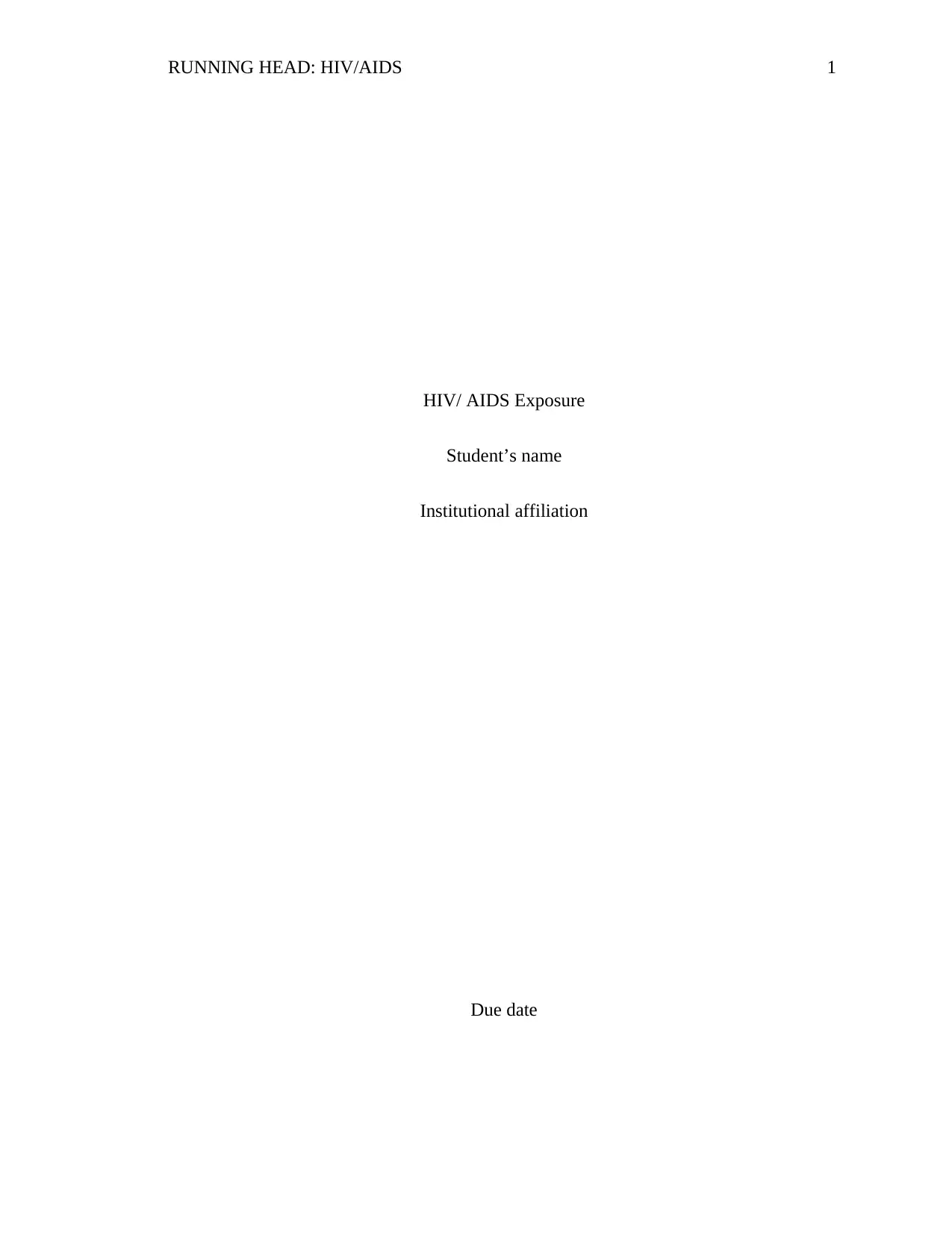
RUNNING HEAD: HIV/AIDS 1
HIV/ AIDS Exposure
Student’s name
Institutional affiliation
Due date
HIV/ AIDS Exposure
Student’s name
Institutional affiliation
Due date
Paraphrase This Document
Need a fresh take? Get an instant paraphrase of this document with our AI Paraphraser
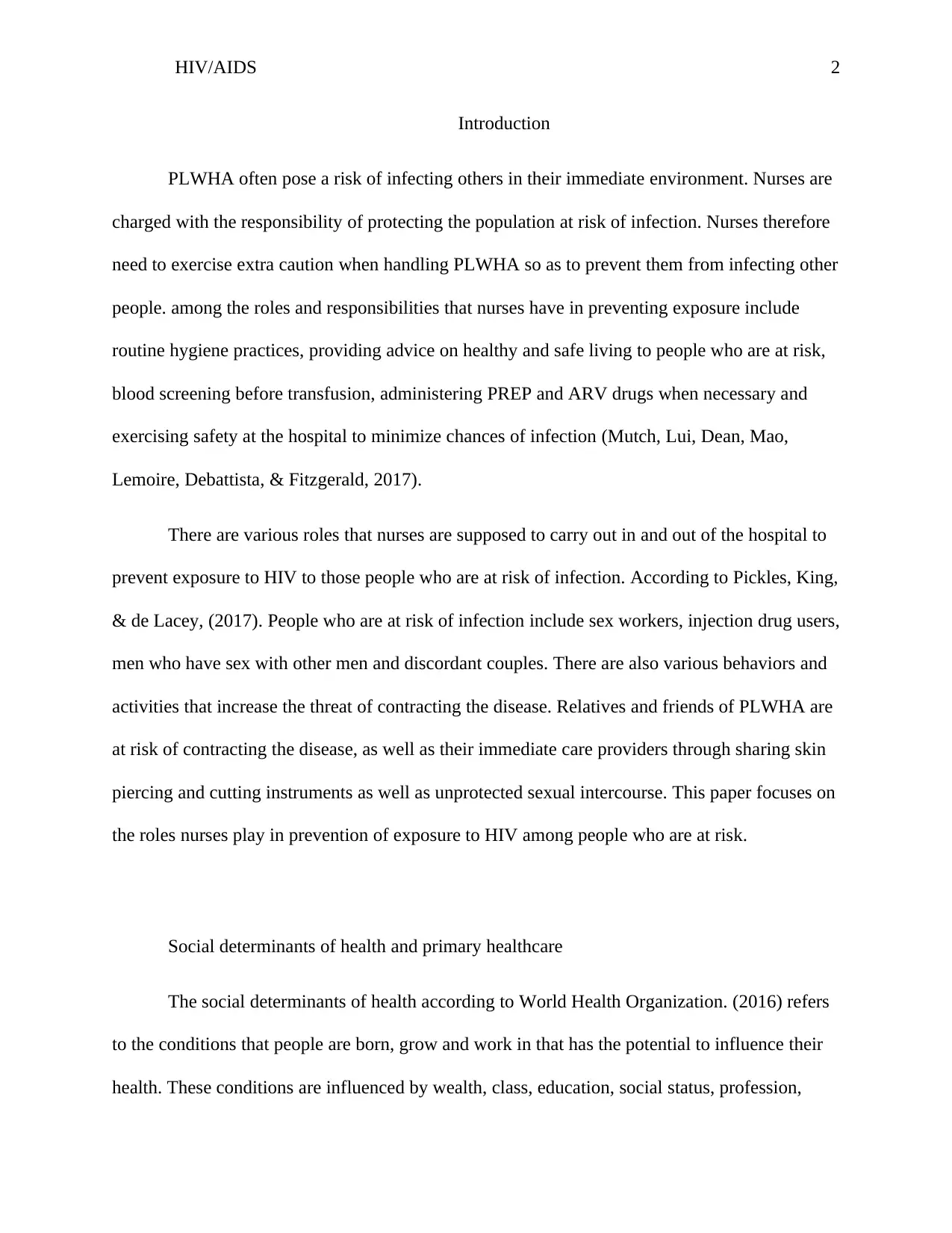
HIV/AIDS 2
Introduction
PLWHA often pose a risk of infecting others in their immediate environment. Nurses are
charged with the responsibility of protecting the population at risk of infection. Nurses therefore
need to exercise extra caution when handling PLWHA so as to prevent them from infecting other
people. among the roles and responsibilities that nurses have in preventing exposure include
routine hygiene practices, providing advice on healthy and safe living to people who are at risk,
blood screening before transfusion, administering PREP and ARV drugs when necessary and
exercising safety at the hospital to minimize chances of infection (Mutch, Lui, Dean, Mao,
Lemoire, Debattista, & Fitzgerald, 2017).
There are various roles that nurses are supposed to carry out in and out of the hospital to
prevent exposure to HIV to those people who are at risk of infection. According to Pickles, King,
& de Lacey, (2017). People who are at risk of infection include sex workers, injection drug users,
men who have sex with other men and discordant couples. There are also various behaviors and
activities that increase the threat of contracting the disease. Relatives and friends of PLWHA are
at risk of contracting the disease, as well as their immediate care providers through sharing skin
piercing and cutting instruments as well as unprotected sexual intercourse. This paper focuses on
the roles nurses play in prevention of exposure to HIV among people who are at risk.
Social determinants of health and primary healthcare
The social determinants of health according to World Health Organization. (2016) refers
to the conditions that people are born, grow and work in that has the potential to influence their
health. These conditions are influenced by wealth, class, education, social status, profession,
Introduction
PLWHA often pose a risk of infecting others in their immediate environment. Nurses are
charged with the responsibility of protecting the population at risk of infection. Nurses therefore
need to exercise extra caution when handling PLWHA so as to prevent them from infecting other
people. among the roles and responsibilities that nurses have in preventing exposure include
routine hygiene practices, providing advice on healthy and safe living to people who are at risk,
blood screening before transfusion, administering PREP and ARV drugs when necessary and
exercising safety at the hospital to minimize chances of infection (Mutch, Lui, Dean, Mao,
Lemoire, Debattista, & Fitzgerald, 2017).
There are various roles that nurses are supposed to carry out in and out of the hospital to
prevent exposure to HIV to those people who are at risk of infection. According to Pickles, King,
& de Lacey, (2017). People who are at risk of infection include sex workers, injection drug users,
men who have sex with other men and discordant couples. There are also various behaviors and
activities that increase the threat of contracting the disease. Relatives and friends of PLWHA are
at risk of contracting the disease, as well as their immediate care providers through sharing skin
piercing and cutting instruments as well as unprotected sexual intercourse. This paper focuses on
the roles nurses play in prevention of exposure to HIV among people who are at risk.
Social determinants of health and primary healthcare
The social determinants of health according to World Health Organization. (2016) refers
to the conditions that people are born, grow and work in that has the potential to influence their
health. These conditions are influenced by wealth, class, education, social status, profession,
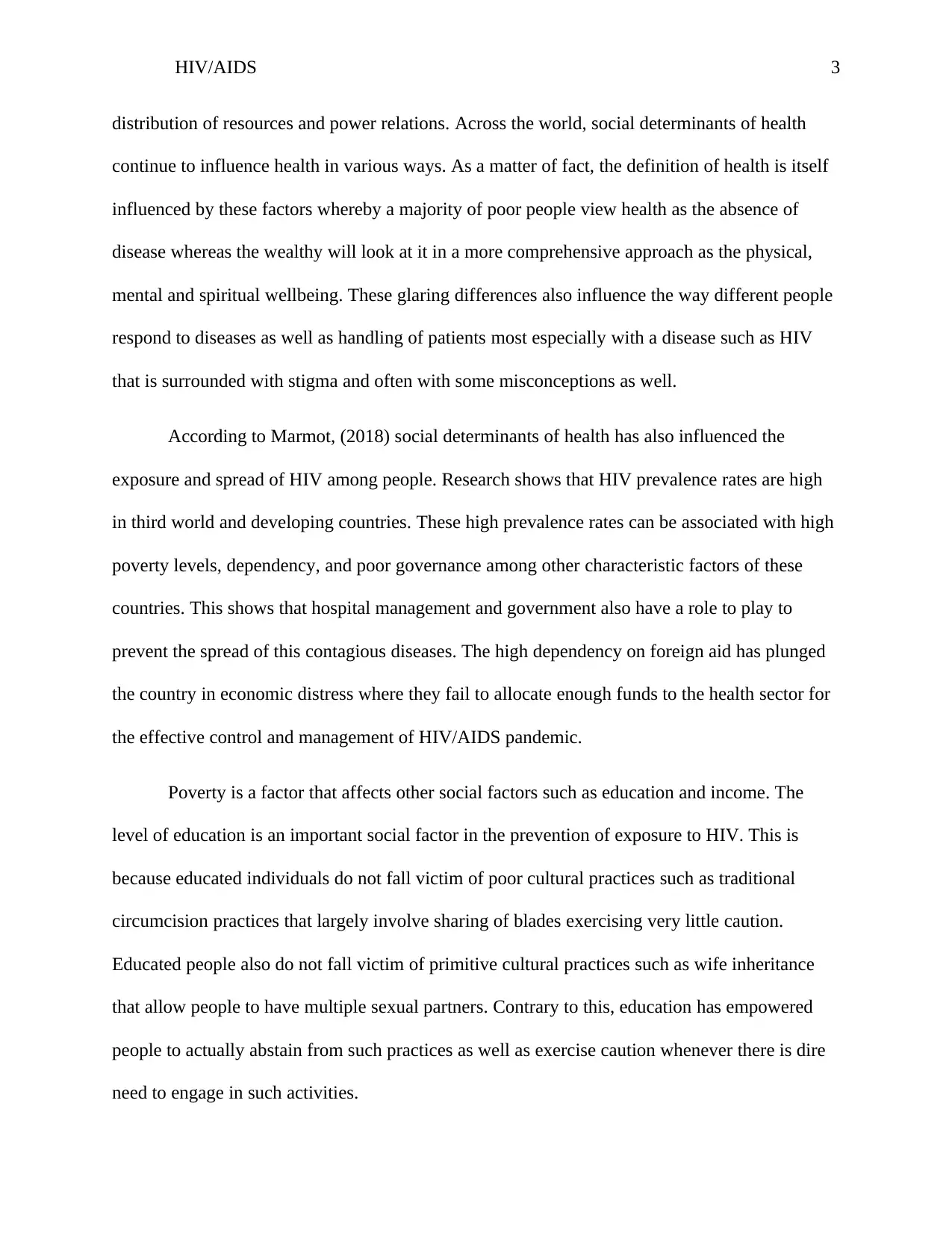
HIV/AIDS 3
distribution of resources and power relations. Across the world, social determinants of health
continue to influence health in various ways. As a matter of fact, the definition of health is itself
influenced by these factors whereby a majority of poor people view health as the absence of
disease whereas the wealthy will look at it in a more comprehensive approach as the physical,
mental and spiritual wellbeing. These glaring differences also influence the way different people
respond to diseases as well as handling of patients most especially with a disease such as HIV
that is surrounded with stigma and often with some misconceptions as well.
According to Marmot, (2018) social determinants of health has also influenced the
exposure and spread of HIV among people. Research shows that HIV prevalence rates are high
in third world and developing countries. These high prevalence rates can be associated with high
poverty levels, dependency, and poor governance among other characteristic factors of these
countries. This shows that hospital management and government also have a role to play to
prevent the spread of this contagious diseases. The high dependency on foreign aid has plunged
the country in economic distress where they fail to allocate enough funds to the health sector for
the effective control and management of HIV/AIDS pandemic.
Poverty is a factor that affects other social factors such as education and income. The
level of education is an important social factor in the prevention of exposure to HIV. This is
because educated individuals do not fall victim of poor cultural practices such as traditional
circumcision practices that largely involve sharing of blades exercising very little caution.
Educated people also do not fall victim of primitive cultural practices such as wife inheritance
that allow people to have multiple sexual partners. Contrary to this, education has empowered
people to actually abstain from such practices as well as exercise caution whenever there is dire
need to engage in such activities.
distribution of resources and power relations. Across the world, social determinants of health
continue to influence health in various ways. As a matter of fact, the definition of health is itself
influenced by these factors whereby a majority of poor people view health as the absence of
disease whereas the wealthy will look at it in a more comprehensive approach as the physical,
mental and spiritual wellbeing. These glaring differences also influence the way different people
respond to diseases as well as handling of patients most especially with a disease such as HIV
that is surrounded with stigma and often with some misconceptions as well.
According to Marmot, (2018) social determinants of health has also influenced the
exposure and spread of HIV among people. Research shows that HIV prevalence rates are high
in third world and developing countries. These high prevalence rates can be associated with high
poverty levels, dependency, and poor governance among other characteristic factors of these
countries. This shows that hospital management and government also have a role to play to
prevent the spread of this contagious diseases. The high dependency on foreign aid has plunged
the country in economic distress where they fail to allocate enough funds to the health sector for
the effective control and management of HIV/AIDS pandemic.
Poverty is a factor that affects other social factors such as education and income. The
level of education is an important social factor in the prevention of exposure to HIV. This is
because educated individuals do not fall victim of poor cultural practices such as traditional
circumcision practices that largely involve sharing of blades exercising very little caution.
Educated people also do not fall victim of primitive cultural practices such as wife inheritance
that allow people to have multiple sexual partners. Contrary to this, education has empowered
people to actually abstain from such practices as well as exercise caution whenever there is dire
need to engage in such activities.
⊘ This is a preview!⊘
Do you want full access?
Subscribe today to unlock all pages.

Trusted by 1+ million students worldwide
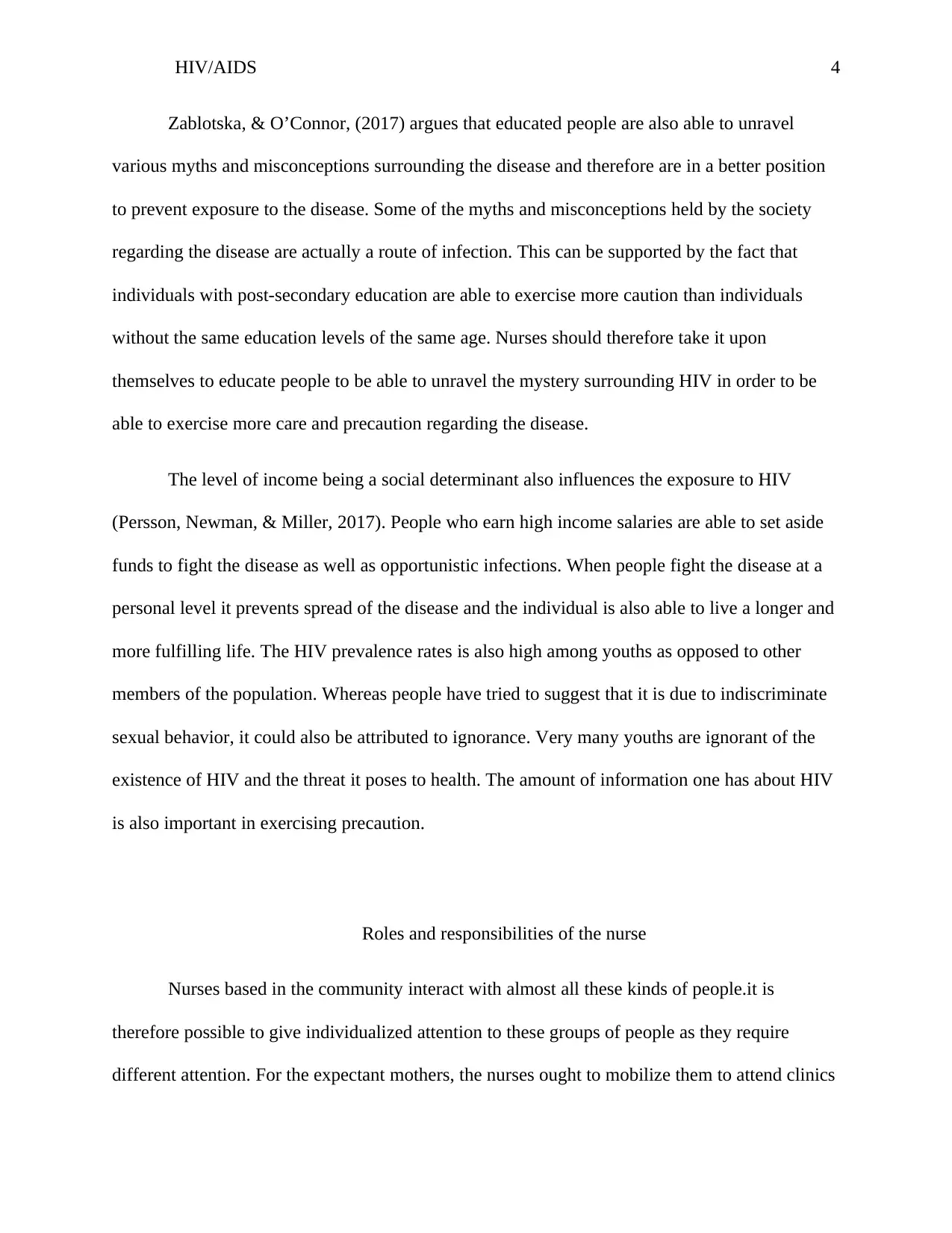
HIV/AIDS 4
Zablotska, & O’Connor, (2017) argues that educated people are also able to unravel
various myths and misconceptions surrounding the disease and therefore are in a better position
to prevent exposure to the disease. Some of the myths and misconceptions held by the society
regarding the disease are actually a route of infection. This can be supported by the fact that
individuals with post-secondary education are able to exercise more caution than individuals
without the same education levels of the same age. Nurses should therefore take it upon
themselves to educate people to be able to unravel the mystery surrounding HIV in order to be
able to exercise more care and precaution regarding the disease.
The level of income being a social determinant also influences the exposure to HIV
(Persson, Newman, & Miller, 2017). People who earn high income salaries are able to set aside
funds to fight the disease as well as opportunistic infections. When people fight the disease at a
personal level it prevents spread of the disease and the individual is also able to live a longer and
more fulfilling life. The HIV prevalence rates is also high among youths as opposed to other
members of the population. Whereas people have tried to suggest that it is due to indiscriminate
sexual behavior, it could also be attributed to ignorance. Very many youths are ignorant of the
existence of HIV and the threat it poses to health. The amount of information one has about HIV
is also important in exercising precaution.
Roles and responsibilities of the nurse
Nurses based in the community interact with almost all these kinds of people.it is
therefore possible to give individualized attention to these groups of people as they require
different attention. For the expectant mothers, the nurses ought to mobilize them to attend clinics
Zablotska, & O’Connor, (2017) argues that educated people are also able to unravel
various myths and misconceptions surrounding the disease and therefore are in a better position
to prevent exposure to the disease. Some of the myths and misconceptions held by the society
regarding the disease are actually a route of infection. This can be supported by the fact that
individuals with post-secondary education are able to exercise more caution than individuals
without the same education levels of the same age. Nurses should therefore take it upon
themselves to educate people to be able to unravel the mystery surrounding HIV in order to be
able to exercise more care and precaution regarding the disease.
The level of income being a social determinant also influences the exposure to HIV
(Persson, Newman, & Miller, 2017). People who earn high income salaries are able to set aside
funds to fight the disease as well as opportunistic infections. When people fight the disease at a
personal level it prevents spread of the disease and the individual is also able to live a longer and
more fulfilling life. The HIV prevalence rates is also high among youths as opposed to other
members of the population. Whereas people have tried to suggest that it is due to indiscriminate
sexual behavior, it could also be attributed to ignorance. Very many youths are ignorant of the
existence of HIV and the threat it poses to health. The amount of information one has about HIV
is also important in exercising precaution.
Roles and responsibilities of the nurse
Nurses based in the community interact with almost all these kinds of people.it is
therefore possible to give individualized attention to these groups of people as they require
different attention. For the expectant mothers, the nurses ought to mobilize them to attend clinics
Paraphrase This Document
Need a fresh take? Get an instant paraphrase of this document with our AI Paraphraser
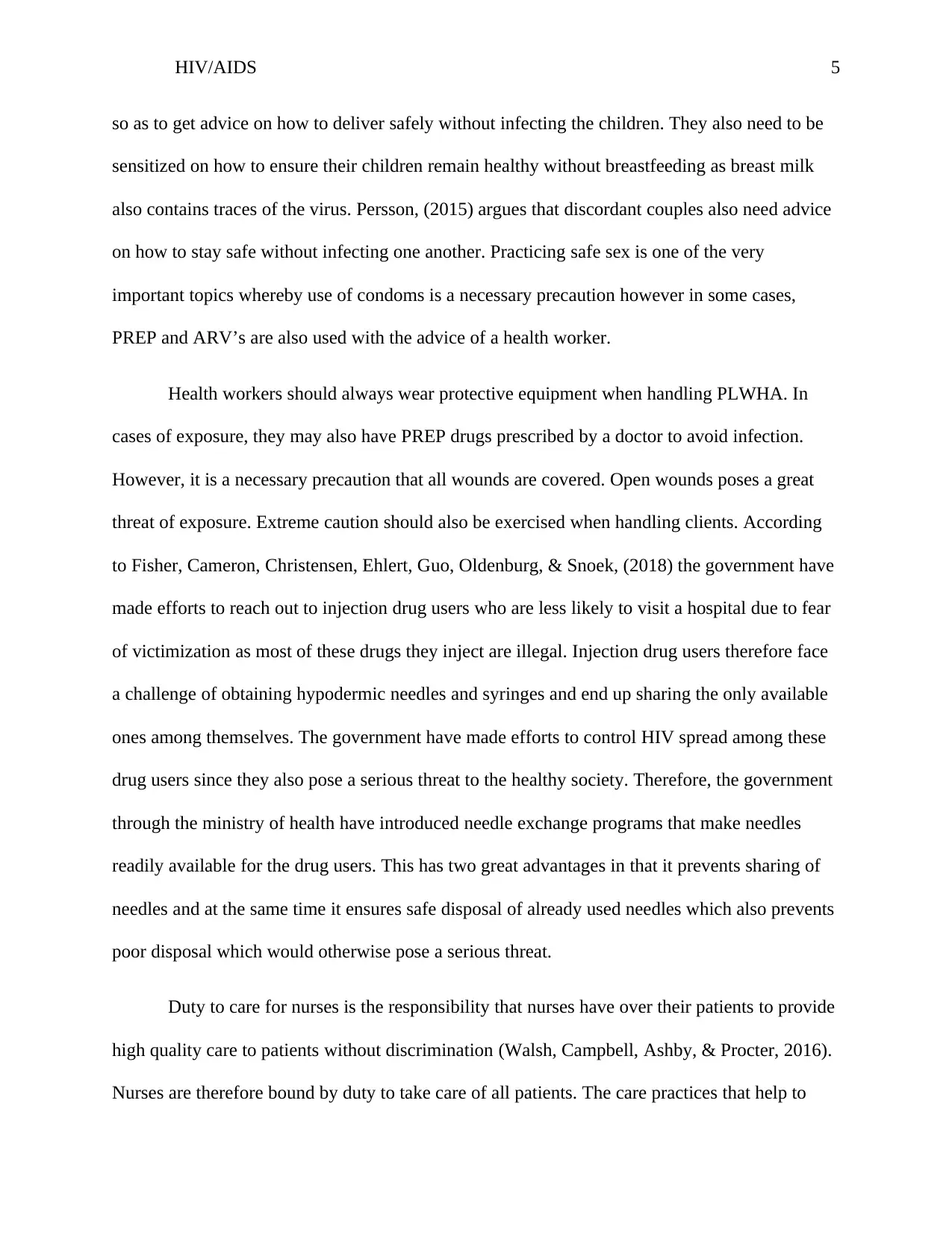
HIV/AIDS 5
so as to get advice on how to deliver safely without infecting the children. They also need to be
sensitized on how to ensure their children remain healthy without breastfeeding as breast milk
also contains traces of the virus. Persson, (2015) argues that discordant couples also need advice
on how to stay safe without infecting one another. Practicing safe sex is one of the very
important topics whereby use of condoms is a necessary precaution however in some cases,
PREP and ARV’s are also used with the advice of a health worker.
Health workers should always wear protective equipment when handling PLWHA. In
cases of exposure, they may also have PREP drugs prescribed by a doctor to avoid infection.
However, it is a necessary precaution that all wounds are covered. Open wounds poses a great
threat of exposure. Extreme caution should also be exercised when handling clients. According
to Fisher, Cameron, Christensen, Ehlert, Guo, Oldenburg, & Snoek, (2018) the government have
made efforts to reach out to injection drug users who are less likely to visit a hospital due to fear
of victimization as most of these drugs they inject are illegal. Injection drug users therefore face
a challenge of obtaining hypodermic needles and syringes and end up sharing the only available
ones among themselves. The government have made efforts to control HIV spread among these
drug users since they also pose a serious threat to the healthy society. Therefore, the government
through the ministry of health have introduced needle exchange programs that make needles
readily available for the drug users. This has two great advantages in that it prevents sharing of
needles and at the same time it ensures safe disposal of already used needles which also prevents
poor disposal which would otherwise pose a serious threat.
Duty to care for nurses is the responsibility that nurses have over their patients to provide
high quality care to patients without discrimination (Walsh, Campbell, Ashby, & Procter, 2016).
Nurses are therefore bound by duty to take care of all patients. The care practices that help to
so as to get advice on how to deliver safely without infecting the children. They also need to be
sensitized on how to ensure their children remain healthy without breastfeeding as breast milk
also contains traces of the virus. Persson, (2015) argues that discordant couples also need advice
on how to stay safe without infecting one another. Practicing safe sex is one of the very
important topics whereby use of condoms is a necessary precaution however in some cases,
PREP and ARV’s are also used with the advice of a health worker.
Health workers should always wear protective equipment when handling PLWHA. In
cases of exposure, they may also have PREP drugs prescribed by a doctor to avoid infection.
However, it is a necessary precaution that all wounds are covered. Open wounds poses a great
threat of exposure. Extreme caution should also be exercised when handling clients. According
to Fisher, Cameron, Christensen, Ehlert, Guo, Oldenburg, & Snoek, (2018) the government have
made efforts to reach out to injection drug users who are less likely to visit a hospital due to fear
of victimization as most of these drugs they inject are illegal. Injection drug users therefore face
a challenge of obtaining hypodermic needles and syringes and end up sharing the only available
ones among themselves. The government have made efforts to control HIV spread among these
drug users since they also pose a serious threat to the healthy society. Therefore, the government
through the ministry of health have introduced needle exchange programs that make needles
readily available for the drug users. This has two great advantages in that it prevents sharing of
needles and at the same time it ensures safe disposal of already used needles which also prevents
poor disposal which would otherwise pose a serious threat.
Duty to care for nurses is the responsibility that nurses have over their patients to provide
high quality care to patients without discrimination (Walsh, Campbell, Ashby, & Procter, 2016).
Nurses are therefore bound by duty to take care of all patients. The care practices that help to
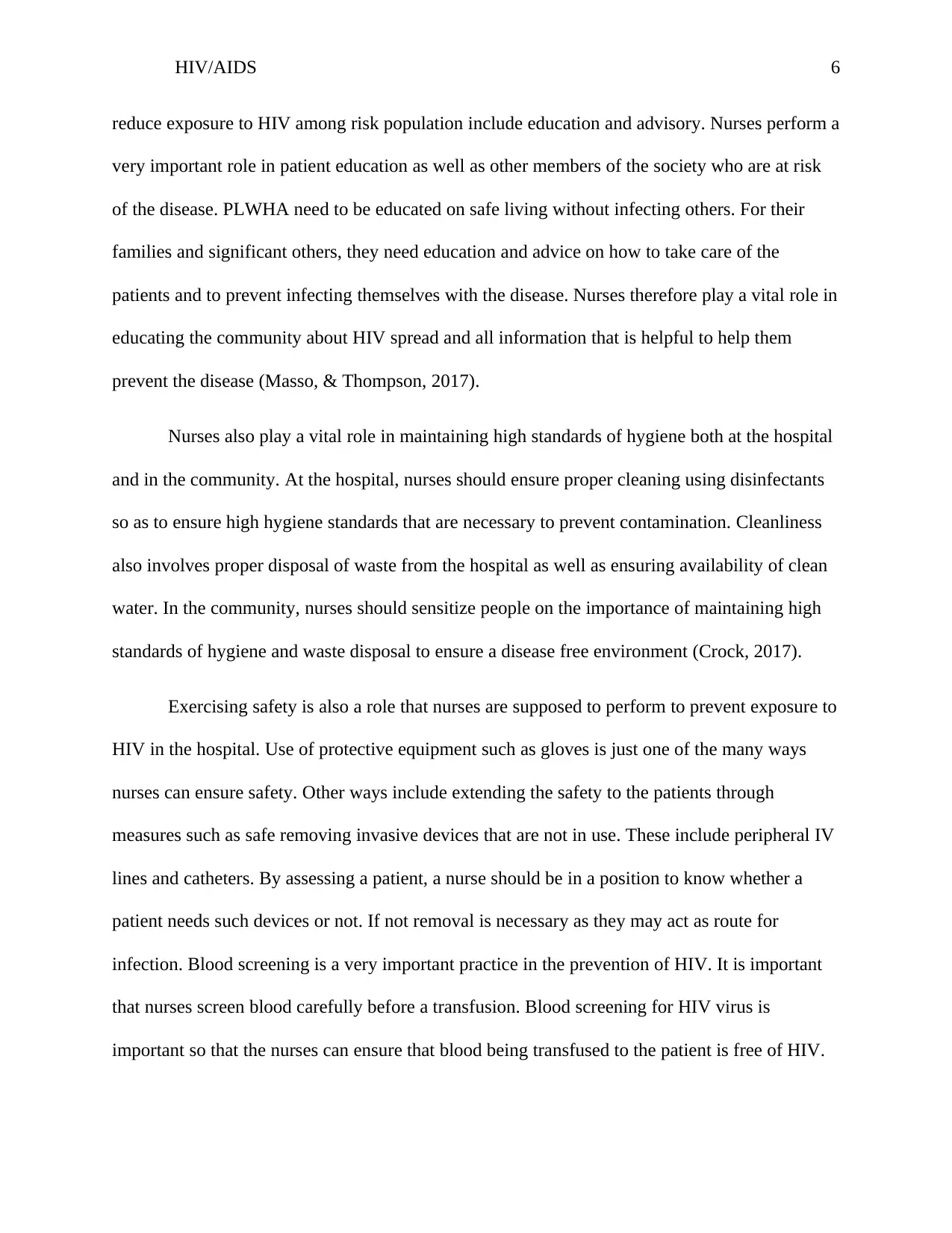
HIV/AIDS 6
reduce exposure to HIV among risk population include education and advisory. Nurses perform a
very important role in patient education as well as other members of the society who are at risk
of the disease. PLWHA need to be educated on safe living without infecting others. For their
families and significant others, they need education and advice on how to take care of the
patients and to prevent infecting themselves with the disease. Nurses therefore play a vital role in
educating the community about HIV spread and all information that is helpful to help them
prevent the disease (Masso, & Thompson, 2017).
Nurses also play a vital role in maintaining high standards of hygiene both at the hospital
and in the community. At the hospital, nurses should ensure proper cleaning using disinfectants
so as to ensure high hygiene standards that are necessary to prevent contamination. Cleanliness
also involves proper disposal of waste from the hospital as well as ensuring availability of clean
water. In the community, nurses should sensitize people on the importance of maintaining high
standards of hygiene and waste disposal to ensure a disease free environment (Crock, 2017).
Exercising safety is also a role that nurses are supposed to perform to prevent exposure to
HIV in the hospital. Use of protective equipment such as gloves is just one of the many ways
nurses can ensure safety. Other ways include extending the safety to the patients through
measures such as safe removing invasive devices that are not in use. These include peripheral IV
lines and catheters. By assessing a patient, a nurse should be in a position to know whether a
patient needs such devices or not. If not removal is necessary as they may act as route for
infection. Blood screening is a very important practice in the prevention of HIV. It is important
that nurses screen blood carefully before a transfusion. Blood screening for HIV virus is
important so that the nurses can ensure that blood being transfused to the patient is free of HIV.
reduce exposure to HIV among risk population include education and advisory. Nurses perform a
very important role in patient education as well as other members of the society who are at risk
of the disease. PLWHA need to be educated on safe living without infecting others. For their
families and significant others, they need education and advice on how to take care of the
patients and to prevent infecting themselves with the disease. Nurses therefore play a vital role in
educating the community about HIV spread and all information that is helpful to help them
prevent the disease (Masso, & Thompson, 2017).
Nurses also play a vital role in maintaining high standards of hygiene both at the hospital
and in the community. At the hospital, nurses should ensure proper cleaning using disinfectants
so as to ensure high hygiene standards that are necessary to prevent contamination. Cleanliness
also involves proper disposal of waste from the hospital as well as ensuring availability of clean
water. In the community, nurses should sensitize people on the importance of maintaining high
standards of hygiene and waste disposal to ensure a disease free environment (Crock, 2017).
Exercising safety is also a role that nurses are supposed to perform to prevent exposure to
HIV in the hospital. Use of protective equipment such as gloves is just one of the many ways
nurses can ensure safety. Other ways include extending the safety to the patients through
measures such as safe removing invasive devices that are not in use. These include peripheral IV
lines and catheters. By assessing a patient, a nurse should be in a position to know whether a
patient needs such devices or not. If not removal is necessary as they may act as route for
infection. Blood screening is a very important practice in the prevention of HIV. It is important
that nurses screen blood carefully before a transfusion. Blood screening for HIV virus is
important so that the nurses can ensure that blood being transfused to the patient is free of HIV.
⊘ This is a preview!⊘
Do you want full access?
Subscribe today to unlock all pages.

Trusted by 1+ million students worldwide
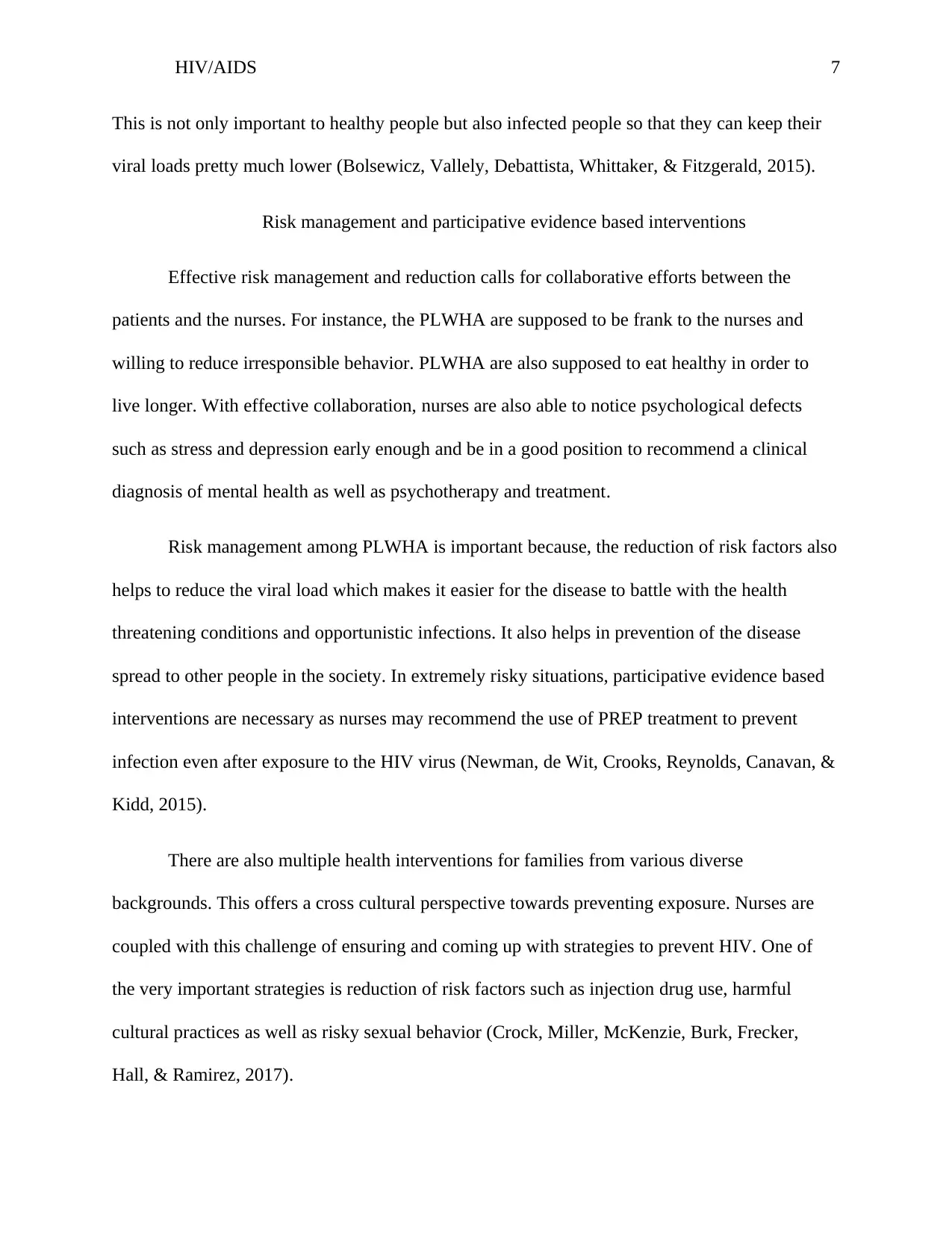
HIV/AIDS 7
This is not only important to healthy people but also infected people so that they can keep their
viral loads pretty much lower (Bolsewicz, Vallely, Debattista, Whittaker, & Fitzgerald, 2015).
Risk management and participative evidence based interventions
Effective risk management and reduction calls for collaborative efforts between the
patients and the nurses. For instance, the PLWHA are supposed to be frank to the nurses and
willing to reduce irresponsible behavior. PLWHA are also supposed to eat healthy in order to
live longer. With effective collaboration, nurses are also able to notice psychological defects
such as stress and depression early enough and be in a good position to recommend a clinical
diagnosis of mental health as well as psychotherapy and treatment.
Risk management among PLWHA is important because, the reduction of risk factors also
helps to reduce the viral load which makes it easier for the disease to battle with the health
threatening conditions and opportunistic infections. It also helps in prevention of the disease
spread to other people in the society. In extremely risky situations, participative evidence based
interventions are necessary as nurses may recommend the use of PREP treatment to prevent
infection even after exposure to the HIV virus (Newman, de Wit, Crooks, Reynolds, Canavan, &
Kidd, 2015).
There are also multiple health interventions for families from various diverse
backgrounds. This offers a cross cultural perspective towards preventing exposure. Nurses are
coupled with this challenge of ensuring and coming up with strategies to prevent HIV. One of
the very important strategies is reduction of risk factors such as injection drug use, harmful
cultural practices as well as risky sexual behavior (Crock, Miller, McKenzie, Burk, Frecker,
Hall, & Ramirez, 2017).
This is not only important to healthy people but also infected people so that they can keep their
viral loads pretty much lower (Bolsewicz, Vallely, Debattista, Whittaker, & Fitzgerald, 2015).
Risk management and participative evidence based interventions
Effective risk management and reduction calls for collaborative efforts between the
patients and the nurses. For instance, the PLWHA are supposed to be frank to the nurses and
willing to reduce irresponsible behavior. PLWHA are also supposed to eat healthy in order to
live longer. With effective collaboration, nurses are also able to notice psychological defects
such as stress and depression early enough and be in a good position to recommend a clinical
diagnosis of mental health as well as psychotherapy and treatment.
Risk management among PLWHA is important because, the reduction of risk factors also
helps to reduce the viral load which makes it easier for the disease to battle with the health
threatening conditions and opportunistic infections. It also helps in prevention of the disease
spread to other people in the society. In extremely risky situations, participative evidence based
interventions are necessary as nurses may recommend the use of PREP treatment to prevent
infection even after exposure to the HIV virus (Newman, de Wit, Crooks, Reynolds, Canavan, &
Kidd, 2015).
There are also multiple health interventions for families from various diverse
backgrounds. This offers a cross cultural perspective towards preventing exposure. Nurses are
coupled with this challenge of ensuring and coming up with strategies to prevent HIV. One of
the very important strategies is reduction of risk factors such as injection drug use, harmful
cultural practices as well as risky sexual behavior (Crock, Miller, McKenzie, Burk, Frecker,
Hall, & Ramirez, 2017).
Paraphrase This Document
Need a fresh take? Get an instant paraphrase of this document with our AI Paraphraser
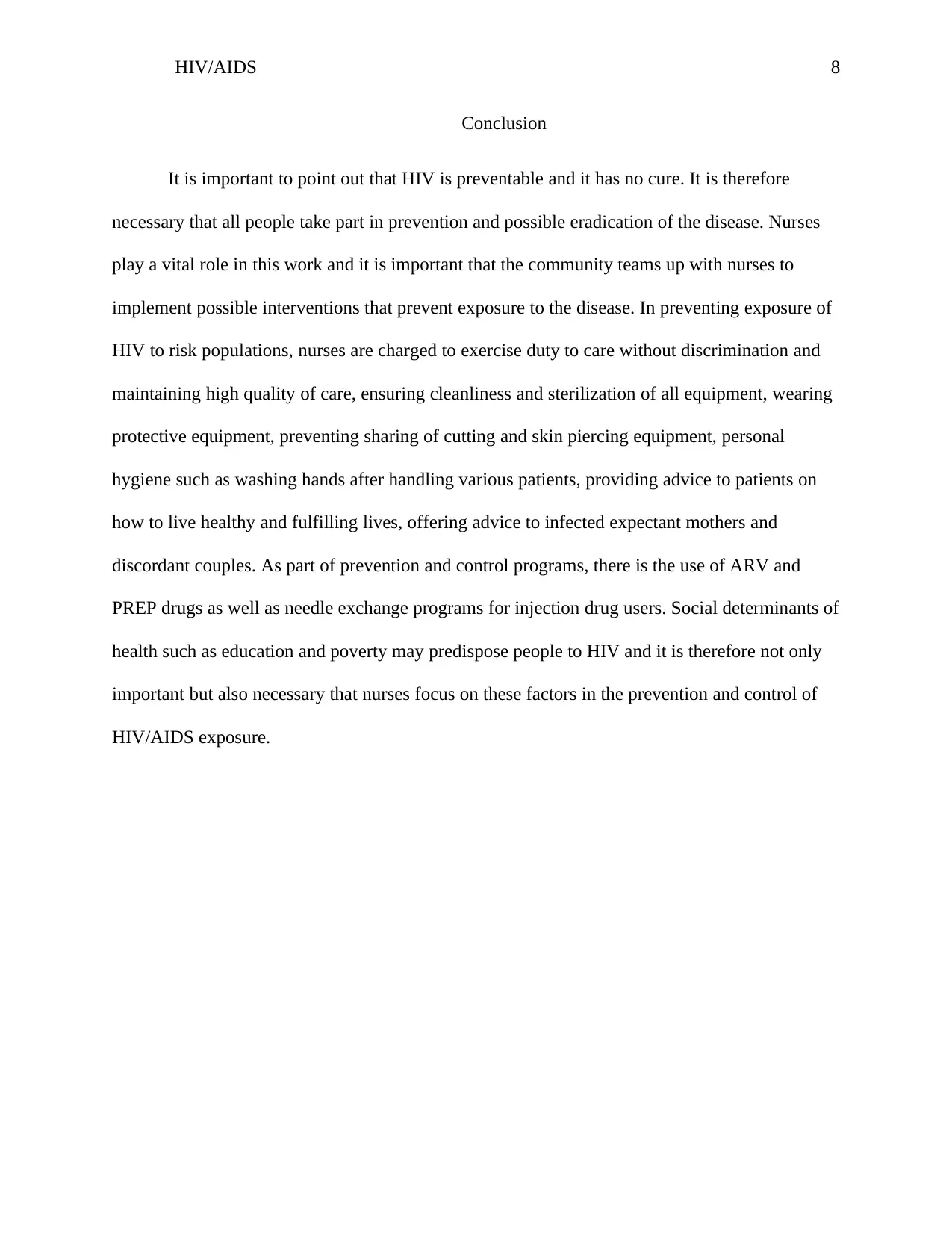
HIV/AIDS 8
Conclusion
It is important to point out that HIV is preventable and it has no cure. It is therefore
necessary that all people take part in prevention and possible eradication of the disease. Nurses
play a vital role in this work and it is important that the community teams up with nurses to
implement possible interventions that prevent exposure to the disease. In preventing exposure of
HIV to risk populations, nurses are charged to exercise duty to care without discrimination and
maintaining high quality of care, ensuring cleanliness and sterilization of all equipment, wearing
protective equipment, preventing sharing of cutting and skin piercing equipment, personal
hygiene such as washing hands after handling various patients, providing advice to patients on
how to live healthy and fulfilling lives, offering advice to infected expectant mothers and
discordant couples. As part of prevention and control programs, there is the use of ARV and
PREP drugs as well as needle exchange programs for injection drug users. Social determinants of
health such as education and poverty may predispose people to HIV and it is therefore not only
important but also necessary that nurses focus on these factors in the prevention and control of
HIV/AIDS exposure.
Conclusion
It is important to point out that HIV is preventable and it has no cure. It is therefore
necessary that all people take part in prevention and possible eradication of the disease. Nurses
play a vital role in this work and it is important that the community teams up with nurses to
implement possible interventions that prevent exposure to the disease. In preventing exposure of
HIV to risk populations, nurses are charged to exercise duty to care without discrimination and
maintaining high quality of care, ensuring cleanliness and sterilization of all equipment, wearing
protective equipment, preventing sharing of cutting and skin piercing equipment, personal
hygiene such as washing hands after handling various patients, providing advice to patients on
how to live healthy and fulfilling lives, offering advice to infected expectant mothers and
discordant couples. As part of prevention and control programs, there is the use of ARV and
PREP drugs as well as needle exchange programs for injection drug users. Social determinants of
health such as education and poverty may predispose people to HIV and it is therefore not only
important but also necessary that nurses focus on these factors in the prevention and control of
HIV/AIDS exposure.
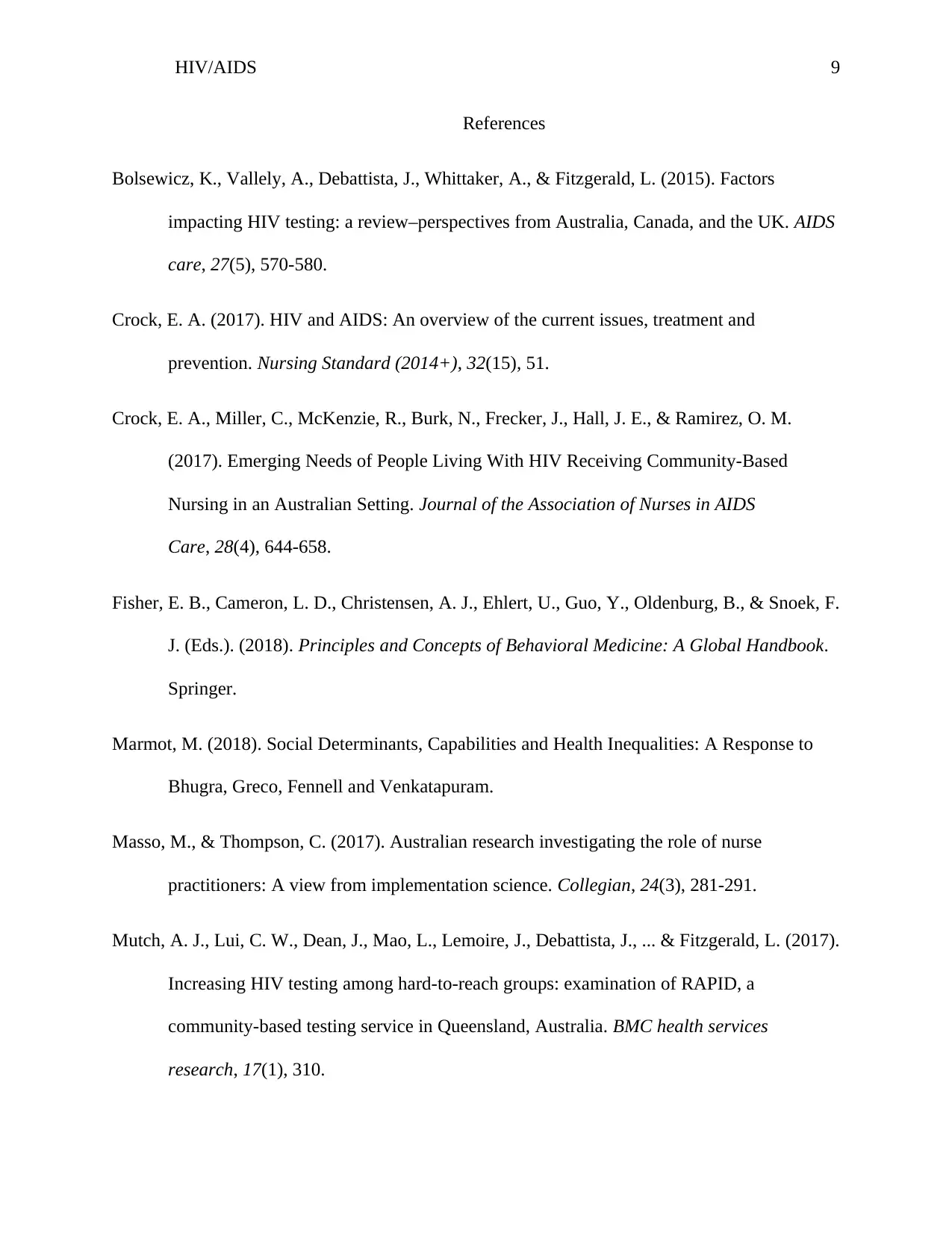
HIV/AIDS 9
References
Bolsewicz, K., Vallely, A., Debattista, J., Whittaker, A., & Fitzgerald, L. (2015). Factors
impacting HIV testing: a review–perspectives from Australia, Canada, and the UK. AIDS
care, 27(5), 570-580.
Crock, E. A. (2017). HIV and AIDS: An overview of the current issues, treatment and
prevention. Nursing Standard (2014+), 32(15), 51.
Crock, E. A., Miller, C., McKenzie, R., Burk, N., Frecker, J., Hall, J. E., & Ramirez, O. M.
(2017). Emerging Needs of People Living With HIV Receiving Community-Based
Nursing in an Australian Setting. Journal of the Association of Nurses in AIDS
Care, 28(4), 644-658.
Fisher, E. B., Cameron, L. D., Christensen, A. J., Ehlert, U., Guo, Y., Oldenburg, B., & Snoek, F.
J. (Eds.). (2018). Principles and Concepts of Behavioral Medicine: A Global Handbook.
Springer.
Marmot, M. (2018). Social Determinants, Capabilities and Health Inequalities: A Response to
Bhugra, Greco, Fennell and Venkatapuram.
Masso, M., & Thompson, C. (2017). Australian research investigating the role of nurse
practitioners: A view from implementation science. Collegian, 24(3), 281-291.
Mutch, A. J., Lui, C. W., Dean, J., Mao, L., Lemoire, J., Debattista, J., ... & Fitzgerald, L. (2017).
Increasing HIV testing among hard-to-reach groups: examination of RAPID, a
community-based testing service in Queensland, Australia. BMC health services
research, 17(1), 310.
References
Bolsewicz, K., Vallely, A., Debattista, J., Whittaker, A., & Fitzgerald, L. (2015). Factors
impacting HIV testing: a review–perspectives from Australia, Canada, and the UK. AIDS
care, 27(5), 570-580.
Crock, E. A. (2017). HIV and AIDS: An overview of the current issues, treatment and
prevention. Nursing Standard (2014+), 32(15), 51.
Crock, E. A., Miller, C., McKenzie, R., Burk, N., Frecker, J., Hall, J. E., & Ramirez, O. M.
(2017). Emerging Needs of People Living With HIV Receiving Community-Based
Nursing in an Australian Setting. Journal of the Association of Nurses in AIDS
Care, 28(4), 644-658.
Fisher, E. B., Cameron, L. D., Christensen, A. J., Ehlert, U., Guo, Y., Oldenburg, B., & Snoek, F.
J. (Eds.). (2018). Principles and Concepts of Behavioral Medicine: A Global Handbook.
Springer.
Marmot, M. (2018). Social Determinants, Capabilities and Health Inequalities: A Response to
Bhugra, Greco, Fennell and Venkatapuram.
Masso, M., & Thompson, C. (2017). Australian research investigating the role of nurse
practitioners: A view from implementation science. Collegian, 24(3), 281-291.
Mutch, A. J., Lui, C. W., Dean, J., Mao, L., Lemoire, J., Debattista, J., ... & Fitzgerald, L. (2017).
Increasing HIV testing among hard-to-reach groups: examination of RAPID, a
community-based testing service in Queensland, Australia. BMC health services
research, 17(1), 310.
⊘ This is a preview!⊘
Do you want full access?
Subscribe today to unlock all pages.

Trusted by 1+ million students worldwide
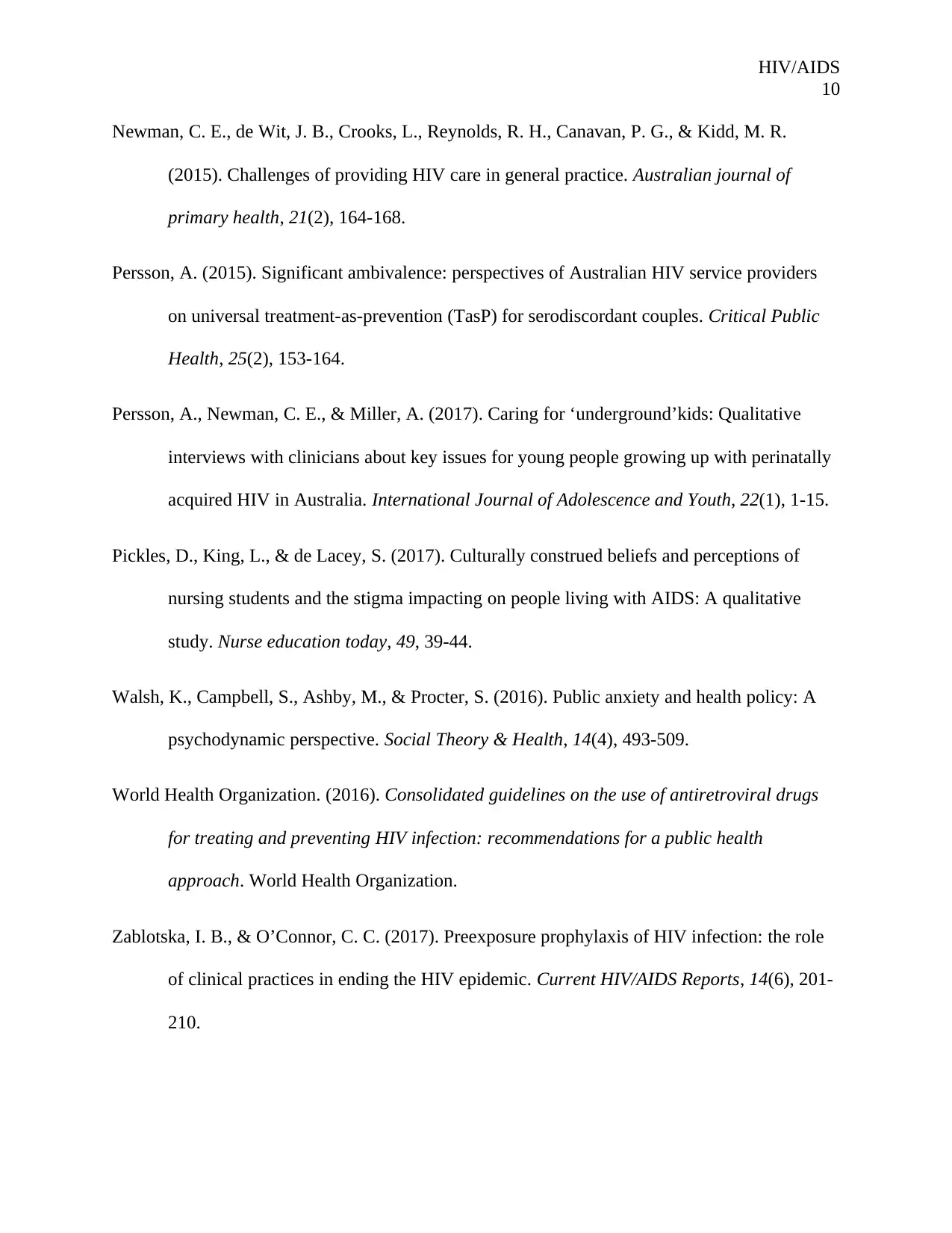
HIV/AIDS
10
Newman, C. E., de Wit, J. B., Crooks, L., Reynolds, R. H., Canavan, P. G., & Kidd, M. R.
(2015). Challenges of providing HIV care in general practice. Australian journal of
primary health, 21(2), 164-168.
Persson, A. (2015). Significant ambivalence: perspectives of Australian HIV service providers
on universal treatment-as-prevention (TasP) for serodiscordant couples. Critical Public
Health, 25(2), 153-164.
Persson, A., Newman, C. E., & Miller, A. (2017). Caring for ‘underground’kids: Qualitative
interviews with clinicians about key issues for young people growing up with perinatally
acquired HIV in Australia. International Journal of Adolescence and Youth, 22(1), 1-15.
Pickles, D., King, L., & de Lacey, S. (2017). Culturally construed beliefs and perceptions of
nursing students and the stigma impacting on people living with AIDS: A qualitative
study. Nurse education today, 49, 39-44.
Walsh, K., Campbell, S., Ashby, M., & Procter, S. (2016). Public anxiety and health policy: A
psychodynamic perspective. Social Theory & Health, 14(4), 493-509.
World Health Organization. (2016). Consolidated guidelines on the use of antiretroviral drugs
for treating and preventing HIV infection: recommendations for a public health
approach. World Health Organization.
Zablotska, I. B., & O’Connor, C. C. (2017). Preexposure prophylaxis of HIV infection: the role
of clinical practices in ending the HIV epidemic. Current HIV/AIDS Reports, 14(6), 201-
210.
10
Newman, C. E., de Wit, J. B., Crooks, L., Reynolds, R. H., Canavan, P. G., & Kidd, M. R.
(2015). Challenges of providing HIV care in general practice. Australian journal of
primary health, 21(2), 164-168.
Persson, A. (2015). Significant ambivalence: perspectives of Australian HIV service providers
on universal treatment-as-prevention (TasP) for serodiscordant couples. Critical Public
Health, 25(2), 153-164.
Persson, A., Newman, C. E., & Miller, A. (2017). Caring for ‘underground’kids: Qualitative
interviews with clinicians about key issues for young people growing up with perinatally
acquired HIV in Australia. International Journal of Adolescence and Youth, 22(1), 1-15.
Pickles, D., King, L., & de Lacey, S. (2017). Culturally construed beliefs and perceptions of
nursing students and the stigma impacting on people living with AIDS: A qualitative
study. Nurse education today, 49, 39-44.
Walsh, K., Campbell, S., Ashby, M., & Procter, S. (2016). Public anxiety and health policy: A
psychodynamic perspective. Social Theory & Health, 14(4), 493-509.
World Health Organization. (2016). Consolidated guidelines on the use of antiretroviral drugs
for treating and preventing HIV infection: recommendations for a public health
approach. World Health Organization.
Zablotska, I. B., & O’Connor, C. C. (2017). Preexposure prophylaxis of HIV infection: the role
of clinical practices in ending the HIV epidemic. Current HIV/AIDS Reports, 14(6), 201-
210.
1 out of 10
Related Documents
Your All-in-One AI-Powered Toolkit for Academic Success.
+13062052269
info@desklib.com
Available 24*7 on WhatsApp / Email
![[object Object]](/_next/static/media/star-bottom.7253800d.svg)
Unlock your academic potential
Copyright © 2020–2025 A2Z Services. All Rights Reserved. Developed and managed by ZUCOL.





